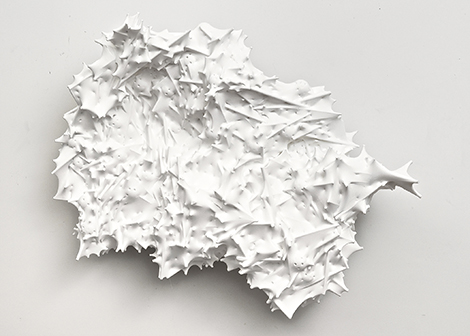Julia von Eichel’s wall sculptures (all 2014) are oddly unsettling, with innards that seem to strain against their outer skin and an overall configuration suggesting movement or attenuated growth. It’s tempting to see naturally occurring phenomenon like spores, stalactites or some kind of intergalactic matter in these objects. With prickly edges and surfaces that are both rutted and smooth, von Eichel’s multivalent sculptures possess a distinctly organic and curiously menacing quality, bringing to mind fierce cloud-like forms, microscopic organisms, or carapaces from some unearthly creature.
It is not easy to determine the materials used in von Eichel’s constructions—are they soft and squishy or hard and shell-like; filigree or dense? Their tactile qualities invite this kind of speculation. The surface is matte white and the way it seems to cling to its superstructure suggests a liquid that was poured and allowed to dry. In actuality, von Eichel stretches silk over a midden of whiffle balls, dowels and thread. She subsequently covers the delicate fabric with layers of gesso, which strengthens it and gives it its fluffy whipped marshmallow quality. The more one looks, the clearer it is; the work is in reality the physical embodiment of the act of creating it.
Von Eichel’s process in making these sculptures is important as it dictates the tension within the work. The artist works with the fabric and its underpinnings concurrently, slowly incorporating dowels and balls and poking and prodding at the material to add shape. Although silk is quite fragile, von Eichel cuts it before the structure is complete so that she has to make whatever size she has cut fit over her growing assemblage. In doing so, she is clearly setting up hurdles that delimit the process, investing the work with a self-imposed struggle.
While she is creating an overall spatial form that has interest and integrity, von Eichel also achieves an ornate surface pattern of recesses and projections. These exploit the play of light and shadow across the surface, enlivening the white surface with a range of grays. The abundant depressions created by thewhiffle balls’ many holes read as black dots against the gessoed silk.
In her early pieces, von Eichel obscured the undersides of her work. More and more, she has begun to expose this previously hidden area and is working towards giving the front and back equal visibility and equal weight. It’s an important aesthetic and symbolic measure, providing both a visual jolt of earthy messiness and also suggesting an entirely other reality roiling beneath an austere surface.
Von Eichel strikes a fine balance between structure and chaos using a highly inventive and improvised technique where she is both at the mercy of the materials and also able to direct them. This notion of control/lack of control seems at the center of the work, which von Eichel developed following the death of her father. Her work acknowledges the exigencies of human emotion and integrates those feelings into a straining, tumultuous whole.



